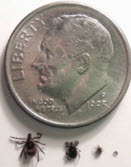Tick Tock, it's Time for a Tick Check
Spring is here and with that folks are getting outside cleaning up from the winter, hiking, camping, and, yes, working. With the unusually mild winter in the East this year, ticks will be out in force.
Ticks thrive in warm wet or humid weather and are moving around already in early April according to a recent Portland Press Herald article outlining a project where ticks were already being gathered for research in Southern sections of Maine.

Ticks present a problem because they are small (under 3mm, about the size of sesame seed), can be difficult to detect before they attach, and are carriers of human diseases like Lyme disease. According to the Centers for Disease Control and Prevention, approximately 30,000 cases of Lyme disease are reported to the agency each year, but that’s not the only malady to be concerned with. Roughly 60 cases of Powassan virus disease were reported in the United States over the past 10 years. Powassan virus is transmitted to humans by the blacklegged tick and groundhog tick. The virus gets its name from Powassan, Ontario where the disease was first discovered. In North America, the majority of cases have been identified in the Midwest and Northeast regions during peak tick season from April to September.
The symptoms of Powassan infection include fever, severe headache, malaise, vomiting, memory loss, difficulty speaking, and loss of coordination. The virus can infect the central nervous system causing inflammation of the brain (encephalitis) and membrane linings (meningitis). Currently, there is no vaccine available to treat the infection with severe illness requiring hospital treatment including respiratory support, intravenous fluid therapy, and anti-inflammatory medication. With the time frame of transmission of tickborne infection from onset of host attachment generally taking longer than 24 hours, careful and prompt removal is critical, hence the time bomb reference in the blog title. For guidance on proper tick removal click on this Tick Removal link to access the CDC’s instruction page.
These diseases can be life altering if not diagnosed and treated in time. Understanding more about ticks and how to protect yourself is crucial. The CDC has put out some good literature about tick borne illness in the United States.
Here are some tips to help keep your Spring and Summer ticking:
- Wear long sleeves and pants when hiking or working in wooded/grassy areas
- Tuck your pants into your socks when hiking
- Treat your clothing (not your skin) with insect repellant that works for ticks (pre-treating and hanging to dry may extend effectiveness)
- Shower or bathe soon after working or playing outdoors
- Frequently check for ticks when working or playing outside
- Check your body thoroughly for ticks
- Under arms,
- In and around hair/neck line, ears, and belly buttons
- Behind knees
- Between legs and around waist band
- Check over your gear and pets
- Tumble clothes in a dryer on high to kill any remaining ticks
For more information on tick and tick borne illness, check out the following links:
- https://www.cdc.gov/nceh/ehs/docs/jeh/2012/june_tick_prevention.pdf
- http://tickinfo.com/
- http://www.cdc.gov/niosh/topics/tick-borne/
- https://www.cdph.ca.gov/HealthInfo/discond/Documents/TicksInTheWorkplaceFactSheet.pdf
- http://www.orkin.com/other/ticks/deer-ticks/
Posted by Peter Koch and Greg LaRochelle
